The big question is: what should my Facebook ad frequency be?
Honestly, that’s probably the wrong question to ask. Frequency by itself doesn’t matter—what matters are the results: sales, visibility, or leads.
You only need to worry about frequency when it starts hurting your performance. For instance, if your results drop or people start hiding your ads because you’re overexposing your custom audiences.
Some marketers overthink ad frequency when they shouldn’t—but for others, it’s a metric that can’t be ignored. It all depends on your context.
Why should you care about Facebook ad frequency?
I’d argue that some people shouldn’t care about Facebook ad frequency—but only if they fully understand the situations where it truly doesn’t matter.
What is Facebook ad frequency?
It’s the average number of times a single user sees your ad during a specific campaign period. While it helps measure repetition, a high frequency can signal ad fatigue.
Excessive frequency can wreck your retargeting campaigns by reducing performance—or worse, prompting people to hide your ads. When that happens, you risk shrinking your retargeting audience, losing access to a group you’ve invested time and resources into building.
What is Facebook ad frequency anyways?
Facebook defines frequency as “the average number of times each person saw your ad.” In simple terms, it’s how often, on average, a single person has seen your ad.
It’s calculated by dividing the number of impressions by the reach. For example, if your ad has 10,000 impressions and a reach of 5,000 people, your frequency would be 2—meaning each person, on average, has seen your ad twice. Not too bad, right?

One word of caution: remember that frequency is an average. This means some people might have seen your ad 5 times while others only saw it once. When you group them together, it could result in an average of 3—but that doesn’t tell the whole story.
Facebook Ads Buying Types: Auction vs. Reach & Frequency
When you’re setting up a Facebook ad campaign, you’ll come across two main buying types: Auction and Reach & Frequency. Understanding the difference between these can help you decide which one best supports your goals.
Auction Buying
Auction is by far the most common ad buying type. It works like a bidding war for ad space. If both you and a competitor are targeting the same audience, the highest bidder usually gets the spot. However, Facebook also looks at factors like your ad’s quality ranking and engagement rates, so it’s not all about price.
This method gives you flexibility and a wide range of options, but the results can be harder to predict. It’s great if you’re looking for flexibility and you don’t mind adjusting as you go.
Reach & Frequency Buying
On the other hand, Reach & Frequency buying is a lot more predictable. With this method, you agree on the number of people you want to reach and lock in a price for that reach. Essentially, you’re reserving your ad space ahead of time, which gives you more control over things like how often your ad shows to the same audience.
This option works best for advertisers with longer sales cycles or those running highly targeted campaigns. It’s a more structured approach when you need consistency and less uncertainty.
How to find your Facebook ads frequency?
Facebook lets you check your frequency at the campaign, ad set, and ad levels. Here’s how you can do it:
#1 – Open Business Manager and navigate to your Ads Manager.

#2 – Click on “column” in the middle right of the screen.
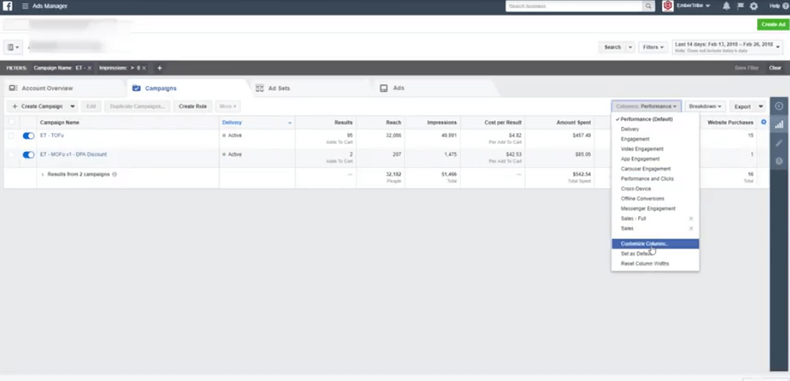
#3 – Select “customize columns” in the dropdown menu.

#4 – Select “Frequency” to make it appear in your ads manager.

Here you go! Now, all you have to do is watch it in your ads manager.
Hot tip: Organize your columns in this order: Impressions >> Reach >> Frequency. Since frequency is calculated as impressions ÷ reach, having them side by side makes it much easier to understand at a glance.
Time-sensitive frequency breaks
If you want to check the frequency of specific campaigns, ad sets, or ads, simply adjust the timeframe in your Ads Manager.
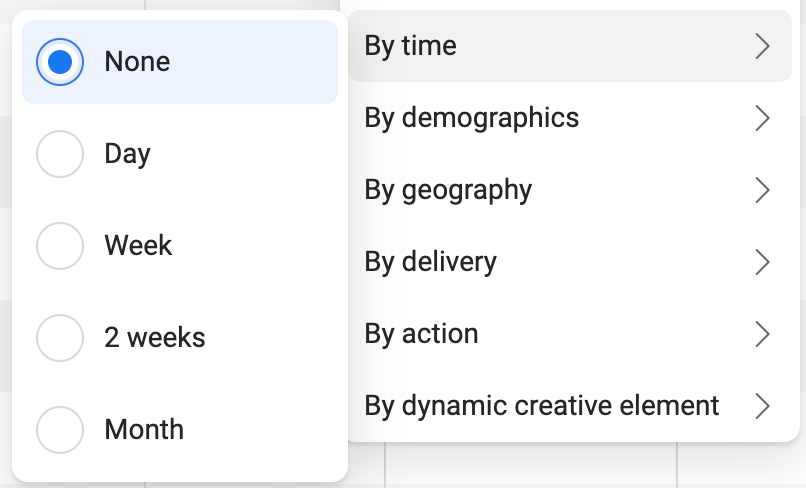
Make sure to select the campaign, ad set, or ad you want to analyze, and you’ll be able to track changes in your Facebook ad frequency daily, weekly, bi-weekly, or monthly.
Don’t forget to set the desired time period in the top-right corner of your Ads Manager.
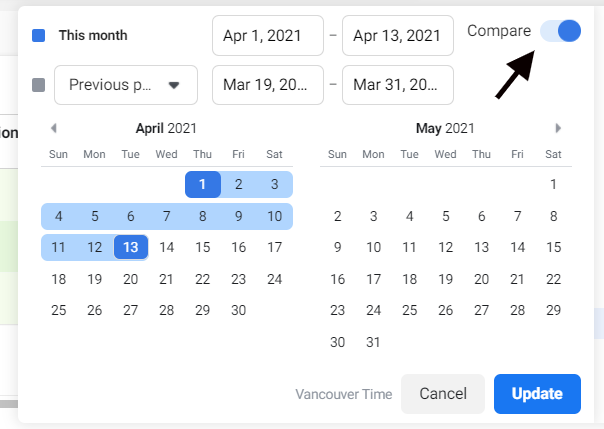
For example, if you want to check the daily Facebook ad frequency for the past week, select “Last 7 Days” and set a “Daily” breakout.
This will show you the ad frequency for each day over the last week, whether at the campaign, ad set, or ad level.
Breakdown frequency breaks
To check the frequency of your campaigns, ad sets, or ads based on metrics other than “time,” simply follow the same steps but choose a different option in the “Breakdown” column.
Here are some of the most popular breakdowns you can use:
- Age
- Gender
- Age & gender
- Country
- Region
- Placements
This way, you can see your ad frequency for people in specific locations like Toronto or New York over a set period. You might find that your frequency in New York is low, but high in Toronto.
With this insight, you could exclude people in Toronto and focus more on targeting your audience in New York.
Here’s a list of all the breakdown options:
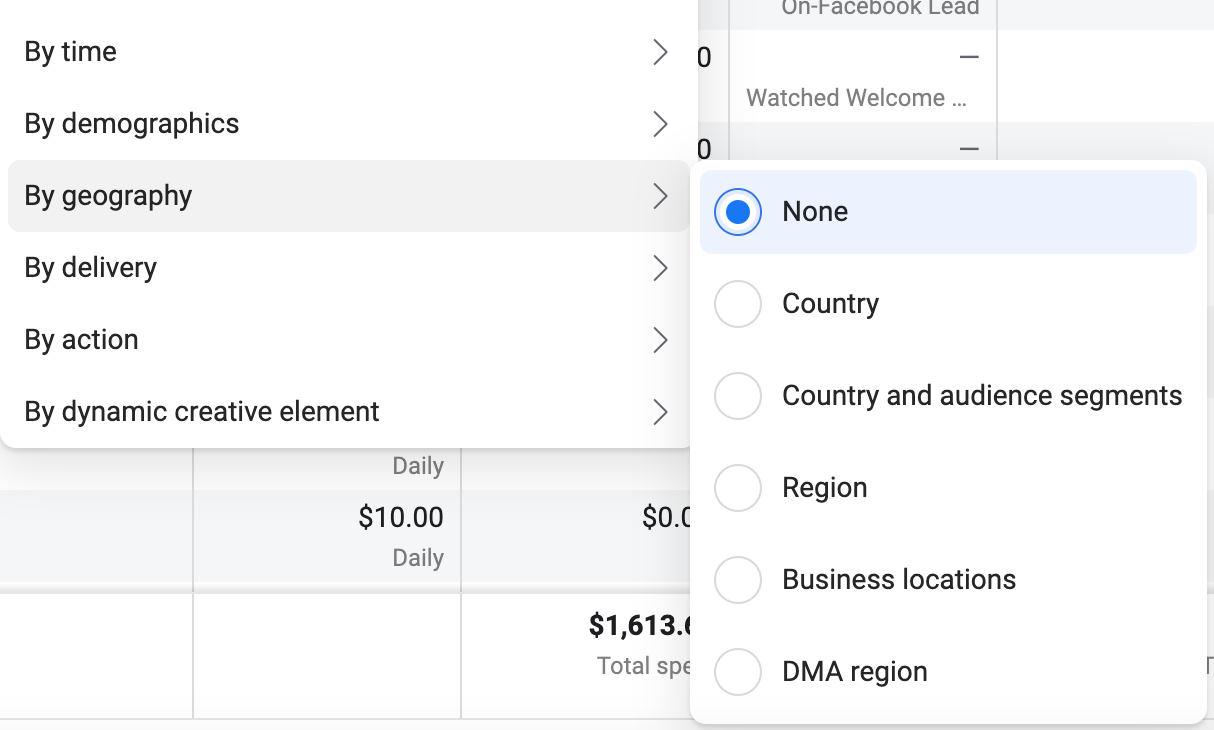
What Facebook ad frequency should I aim for?
This is the most common question when it comes to Facebook ad frequency, so let me give you a brief answer.
Facebook suggests that after a frequency of 2, your brand lift starts to plateau, meaning your results stop improving. They have an article on this topic called Effective Frequency, which I highly recommend checking out.
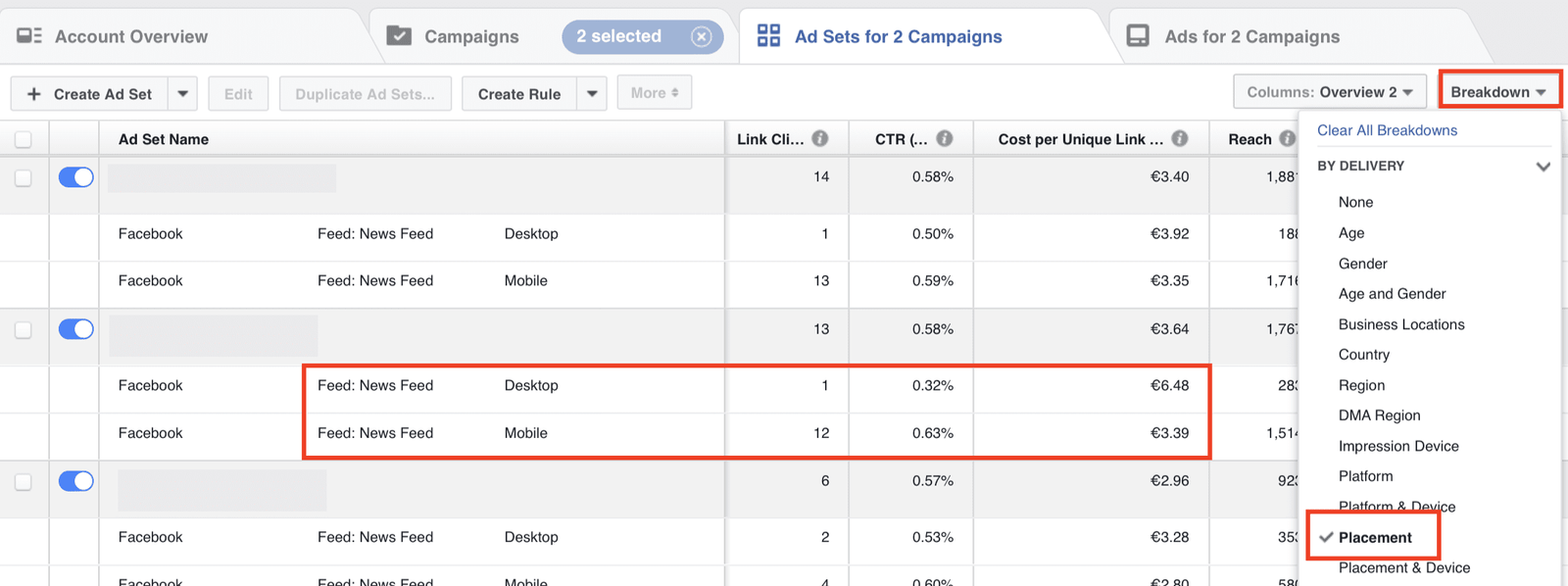
I’d argue against that because we’ve had accounts where the ad frequency reached 16 on certain campaigns, and the results were fantastic.
I also like this chart from Facebook, which can give you a better idea of when it’s appropriate to use a high frequency.

One of our clients with a really high frequency was a festival, and the frequency peaked right before it kicked off.
It was definitely a high season, and we were rotating ad creatives frequently. The purchase cycle was short too, since people would buy tickets for shows happening the same day and might be interested in buying tickets for other events later.
This shows that there are times when keeping your ad frequency low makes sense, and others when a high frequency is perfectly fine.
Here are two essential strategies to consider if your frequency starts getting too high:
#1 – Rotating a lot of different ad creatives
Rotating your ad creatives is the best way to ensure people see fresh perspectives on your brand each time.
If you’ve shown the same ad twice to the same people, it’s probably time to switch things up.
When we talk about ad rotation, we mean having a high creative rotation—this means running 10 different ads with varying images, marketing angles, and copy. Your goal is to keep your strategy dynamic and better resonate with your audience.
Hot tip: If one of your creatives is burning through the budget, set a rule to turn it off when its frequency hits 2 in its lifetime.
#2 – Breakdown your audiences based on placement
You might notice that your overall ad frequency is high, but actually quite normal when you break it down by placements like Facebook News Feed, Instagram Stories, etc.
In fact, you’ll want to show your ad across as many placements as possible. That’s why we recommend checking the frequency per placement for your campaign, ad set, or ad.
Depending on your objective, you might find that frequency is highest on certain placements, and you could exclude those to shift your ads toward underdelivered placements.
Where can you find this?
Just click on “Breakdown” in the middle right of your screen, then select “Delivery” and choose “Placement.”
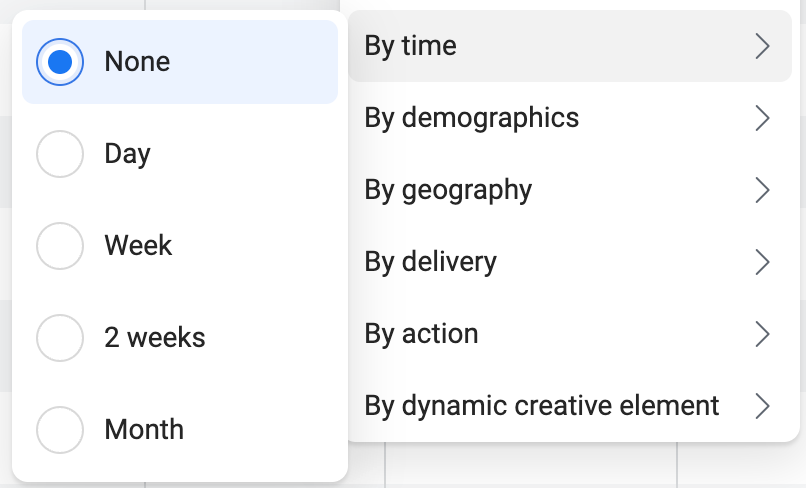
Some placements may be less effective, making them less competitive. Fewer advertisers competing for the same space means cheaper traffic, which could lead to higher ROI.
At a time when everyone was advising against Instagram advertising, I was spending over $10,000 a day on that placement alone—and the results were incredible.
When to Choose Lower Ad Frequency (Less Than 10 Impressions per Month) in a Retargeting Campaign
For many marketers, keeping ad frequency below 10 impressions per month is a common choice. Here’s when that approach works best:
Brand Awareness
If the goal is simply to raise awareness and not drive immediate sales, a lower frequency can be more effective. Showing your ad a few times, around 3 to 5 impressions per month, is usually enough to familiarize your audience with your brand without overwhelming them. This strategy is ideal when you’re more focused on exposure rather than action.
Additionally, lower frequency ads can help position your brand as more exclusive. For instance, high-end brands often use this approach to convey prestige, ensuring that they don’t saturate their audience with too many ads, which keeps the brand feeling rare and desirable.
Top of Funnel (TOFU) Audiences
At the beginning of the customer journey, your audience may still be unfamiliar with your brand. For these individuals in the awareness stage, limiting ad exposure to just a few impressions per month helps to avoid ad fatigue. Overexposing ads to people who aren’t yet interested in making a purchase can reduce the chances of engagement or conversion.
Product Price Considerations
The price of your product is a key factor in determining how often to show your ad. For lower-cost items, people are more likely to make impulse purchases, so you can afford a higher frequency. However, for more expensive products, frequent ad exposure is less effective, as customers tend to make more thoughtful, deliberate decisions. For products priced between $100 and $500, aim for a frequency of 5-7 impressions per month. For products over $500, it’s best to keep the frequency even lower—around 2-4 times per month.
When to Choose Higher Ad Frequency (20+ Impressions per Month) in a Retargeting Campaign
While higher ad frequency is often avoided, there are situations where it can be beneficial:
Brands with Established Presence
For brands with a solid following and recognition, increasing the ad frequency can help reinforce the brand’s message and encourage conversions. When your audience is already familiar with your brand, more frequent ads can serve as reminders that drive action. High frequency can be particularly effective in keeping your brand top of mind for customers who are already considering a purchase.
Time-Sensitive Offers
When running a limited-time offer or a special promotion, a higher frequency is useful to create urgency. If you’re trying to push a time-sensitive product or deal, showing your ad more often to those who haven’t yet engaged can prompt them to take action before the offer expires. This can be particularly effective in pushing people to convert who may otherwise have delayed their decision.
Is your frequency a problem?
In the early days of Facebook advertising, we used ad frequency to measure ad fatigue. Over time, it evolved into a signal to check the negative feedback score to see if people weren’t engaging with our ads.
Now, there’s no more negative feedback score—just quality scores.
You can add these to your columns by following these steps:
#1 – Click on “Columns” in the middle right of your Ads Manager.

#2 – Click on “customize columns“.

#3 – Select “Quality rankings“, and you’ll see in your columns.
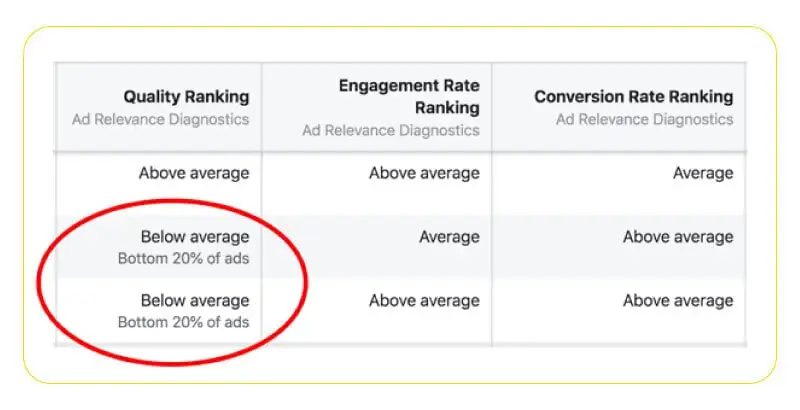
Now, you’ll be able to see whether your ads (since it doesn’t apply at the campaign or ad set level) have a below-average, average, or above-average ranking. This will help you gauge if your ad frequency is negatively impacting your performance.
Of course, if your frequency is rising and your results are dropping, that’s another clear sign it’s time to adjust your strategy before it’s too late.
How to control ad frequency
If you’re fed up with the whole thing and want to take control of your Facebook ad frequency, we’ve put together a list of strategies you’ll love.
These methods can definitely help, but the best one for you really depends on your situation.
If you’re spending a lot on Facebook ads, finding tools to simplify your work is crucial.
If you’re not spending much, we recommend handling it manually—you’ll always get better results when you do it yourself.
#1 – Doing it manually: This is probably the best approach if you have the time for it. You can check your frequency, quality rankings, and results to make informed decisions. If your frequency is negatively impacting your performance, you can add new creatives, adjust your targeting, and more.
This method works well because it gives you the time to evaluate your quality rankings and results, ensuring you don’t turn off an ad where a high frequency isn’t harming your Facebook ads. Just be cautious when making changes, as it could reset the learning phase of your ads.
#2 – The Reach Objective: Using the reach objective lets you set a frequency cap. For example, you could limit the frequency to a maximum of 2, meaning your ad will never exceed that average.
However, this isn’t the best option overall because the reach objective is rarely the most effective—except when you’re running Facebook ads for retargeting.
#3 – Setting up Automated Rules: You can create an automated rule to turn off an ad or lower its budget when it reaches a certain frequency. This is a good strategy if you can’t manage it manually. We typically lower the budget when the frequency hits a threshold until the stats improve.
To set this up, go to your Business Manager and select “Automated Rules.”
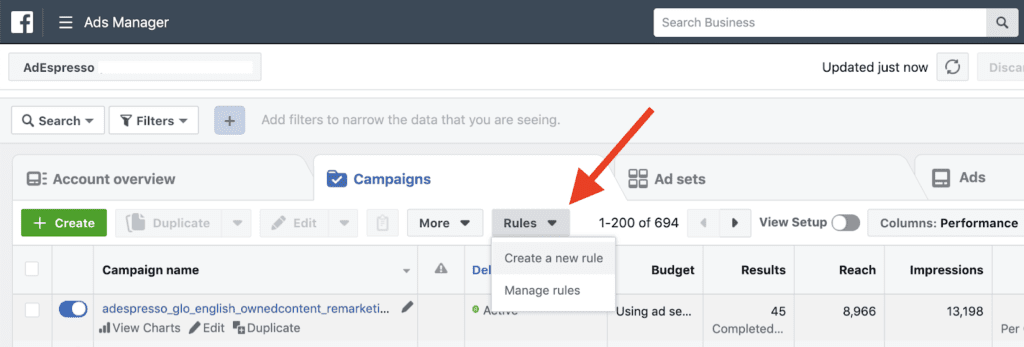
Then, you’ll be prompted to create an automated rule, and it’ll look like this:
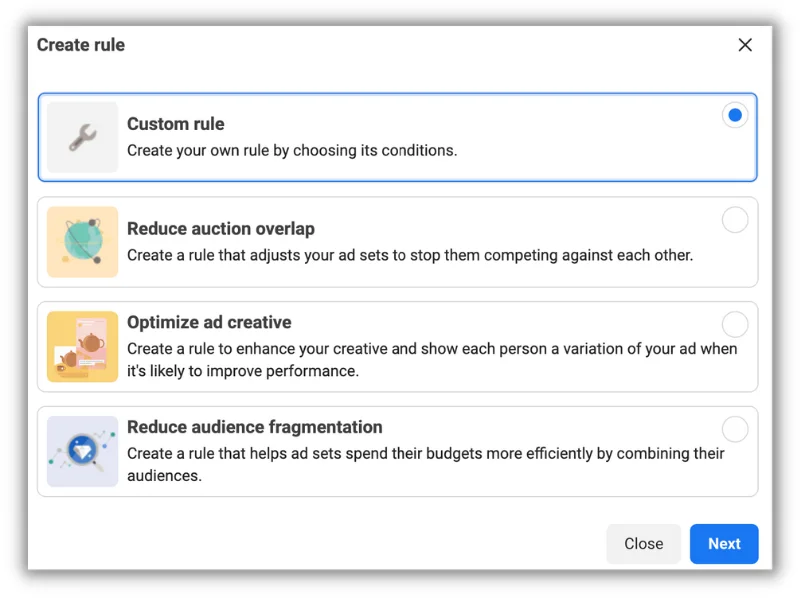
There are plenty of ways to leverage Facebook Automated Rules, so if you want to learn more, check out this Facebook guide.
#4 – Leveraging Reach & Frequency Buying: This is a tool from Facebook that lets you set specific goals for your reach in advance. However, there are two downsides.
First, it’s not available to all advertisers. Second, it locks in your pre-determined goals, meaning you can’t adjust them later. If your ad performs well, you won’t be able to increase your budget to capitalize on its success.
A quick summary
I understand that all these points might be confusing, so here’s a list of actionable insights from this article in bullet points:
- There’s no ideal frequency; it depends on your specific situation.
- High frequency isn’t bad if your quality score is good and your results aren’t suffering.
- There are multiple ways to better control your frequency and maximize your results.

